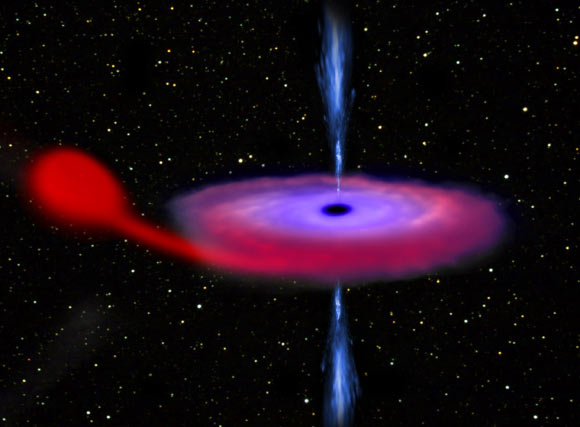Violent red flashes have been observed during the 2015 outburst of the nearby black-hole V404 Cygni.

An artist’s impression of a black hole, similar to V404 Cygni, devouring material from an orbiting companion star. Image credit: ESO / L. Calçada.
V404 Cygni is a binary system comprising a black hole and a star orbiting one another. It is located in our Milky Way Galaxy, approximately 7,800 light-years away in the constellation Cygnus.
In this type of binary system, material flows from the star towards the black hole and gathers in a disc, where it is heated up, shining brightly at optical, UV and X-ray wavelengths before spiraling into the black hole.
In June 2015, V404 Cygni underwent dramatic brightening for several days. In a new study, published in the journal Monthly Notices of the Royal Astronomical Society, astronomers report that V404 Cygni emitted dazzling red flashes lasting just fractions of a second, as it blasted out material that it could not swallow.
The astronomers, led by Dr. Poshak Gandhi from the University of Southampton, UK, associated the red color with fast-moving jets of matter that were ejected from close to the black hole.
These observations provide new insights into the formation of such jets and extreme black hole phenomena.
“The very high speed tells us that the region where this red light is being emitted must be very compact,” Dr. Gandhi said.
“Piecing together clues about the color, speed, and the power of these flashes, we conclude that this light is being emitted from the base of the black hole jet. The origin of these jets is still unknown, although strong magnetic fields are suspected to play a role.”
“Furthermore, these red flashes were found to be strongest at the peak of the black hole’s feeding frenzy.”
“We speculate that when the black hole was being rapidly force-fed by its companion orbiting star, it reacted violently by spewing out some of the material as a fast-moving jet,” he said.
“The duration of these flashing episodes could be related to the switching on and off of the jet, seen for the first time in detail.”
_____
P. Gandhi et al. 2016. Furiously Fast and Red: Sub-second Optical Flaring in V404 Cyg during the 2015 Outburst Peak. MNRAS, published online March 14, 2016; doi: 10.1093/mnras/stw571







